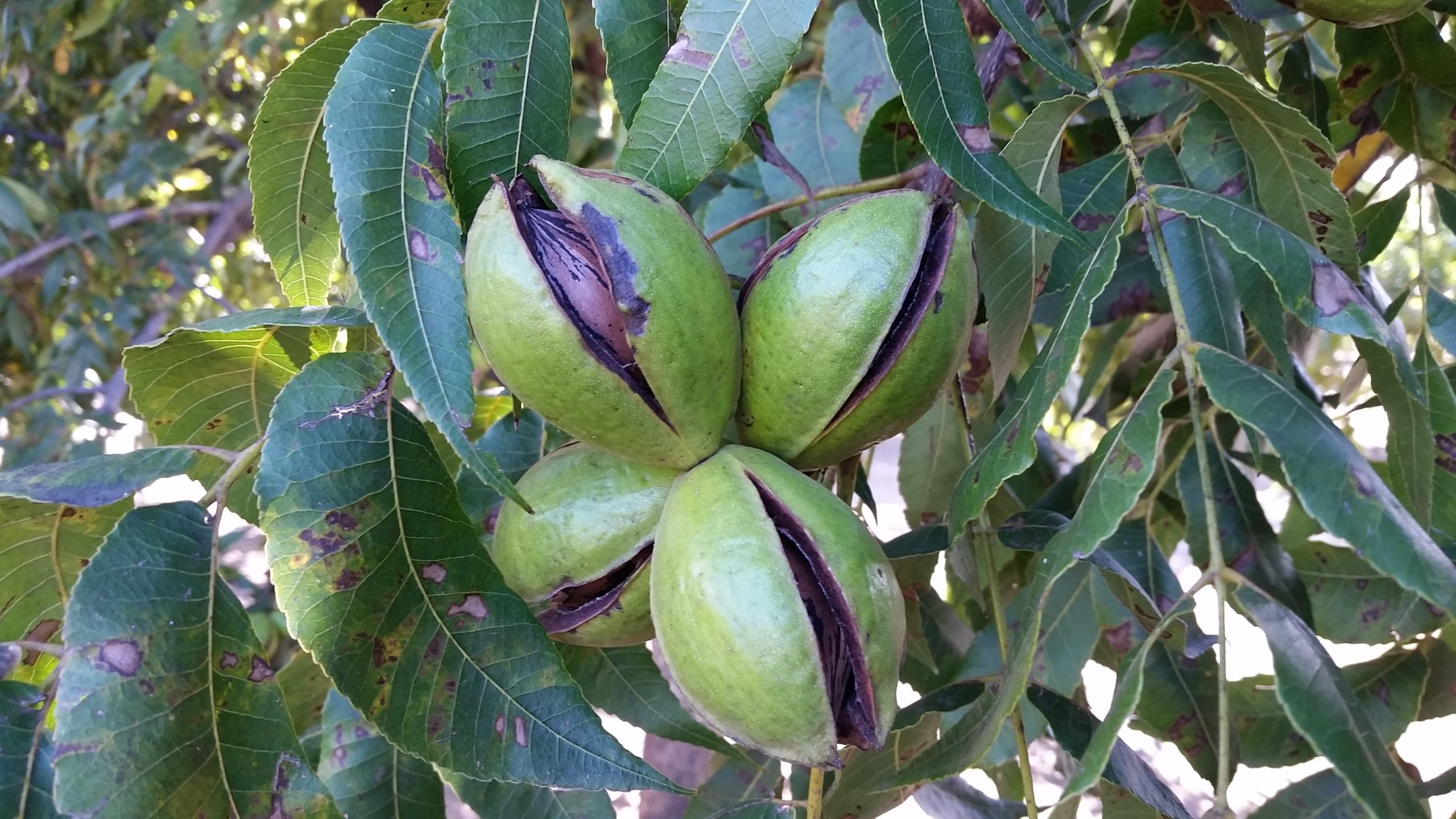Shuck Split is Pecan’s Annual Biochemical Ballet

Shuck-split is almost complete for these pecans in San Simon, Arizona. (Photo by Joshua Sherman)
Yes, I am speaking of the shuck.
Some may also call it a husk. But, what is it doing this time of year? What causes it to gradually split open, dry up, and allow the fruit to fall from the tree?
In short, the answer is that it’s a dynamic process involving plant chemicals, the tree controls through signals. I hope here to explain this in some more detail and bring to light the fascinating occurrence of shuck split.
The shuck is basically a modified leaf. I know it’s hard to imagine for some. Modified leaves, though, have been evolved by plants to perform special functions other than carbohydrate production.
There are other examples of modified leaves in other plants. For example, the spines on cacti, thorns on roses, and the tendrils of grapes, grabbing hold of the trellis. These are all modified leaves. The pecan shuck, however, is directly at that shell-shuck interface for the pecan kernel to acquire all the necessary nutrients and water by veins underneath the shuck surface.
The understanding of the pecan shuck’s anatomy can be attributed to the work of some of our peers that began in the late 1800s but more extensively in the 1920s. Explanations given here have been extrapolated by a more recent work published in the Journal of the American Society of Horticultural Sciences in 1995 by Darrell Sparks and Ida Yates.
Sparks and Yates further investigated the role of the inner shuck tissue zone. This zone is right smack up against the shell of the pecan—the interface. They also observed the separation of the shuck at the four suture sites around the outside of the shuck. And finally, they observed the separation of the vascular system from the shuck. They explain how this vascular system is what causes the dots and irregular stripes on the pecan nuts’ shells that are identifiable markings for every pecan cultivar type. The genetic expression of each cultivar determines these markings. This work by Sparks and Yates is remarkable and has contributed to this understanding of the morphology of shuck abscission (the natural detachment of leaves or fruit).
Intercellular signals are also at play here. Acting simultaneously to the processes above, these signals give way to phytohormone, or plant hormone production, and make this a dynamic process. act simultaneously to the processes above, making this a dynamic process altogether.
Plant hormones at very low concentrations evoke a physiological response. Some plant hormones promote and some inhibit certain growth or development of plant tissue. Then, some of them are translocated through the vascular system, whereas others can be locally created at a specific location, or cell, where the development is occurring.
The five most accepted groups of plant hormones are abscisic acid, auxins, cytokinins, gibberellins, and ethylene. There was some debate about other compounds meeting, or not meeting, the definition of a plant hormone (one that is transported), but we won’t take up more space on that here. These plant hormones are involved in many processes of development, including the early stages of development, flowering, and fruit set. I suspect we will see new research in this area in publication soon.
When it comes to shuck split, the research and literature indicate there are at least a few of these plant hormones acting in an almost orchestrated dance with one another around the shuck and fruit. I say this because the plant hormones are in low concentrations. Too much of one type of inhibiting hormone would cause development to significantly slow, while on the other hand, too much of a promotor hormone would cause excessive growth.
Based off of a variety of published work and literature, I see that there are promoter and inhibitory plant hormones working together in pecan fruit development. When the kernel of the pecan has completely encompassed the empty space in the shell, physiological signals occur within the shuck and a growth promoter hormone—indole-3-acetic acid—decreases in concentration. While at the same time, an inhibitor plant hormone—abscisic acid—increases in concentration. These two plant hormones, along with yet another—ethylene, a gaseous hormone that causes fruit ripening and increases in concentration—contribute to the dynamic shuck-split process.
One published work—Lipe and Morgan (1972)—indicates that the internal levels of ethylene must rise to a specified level of concentration before the shuck-split process is initiated. Also, Chin and Young (1980) determined that abscisic acid alone doesn’t cause the shuck to split, rather the decreasing concentration of another plant hormone, indole-3-acetic acid, occurs before shuck split progresses.
These dynamics are part of the complex process happening within the shuck, specifically along the four sutures and within the internal layers close to the shell. Eventually, this biochemical dance causes the gradual shuck split along the sutures—from the tip all the way to the base—which opens until the magnificent pecan can be released from the tree.
What a dance! Also, just to note, the fruiting process is stressful on the tree. So, we need to help the trees by reducing stress in other areas throughout the fruit development process.
During development, water and nutrients, in excess or deficient, should be at their optimum to help alleviate some of this fruiting stress. Otherwise, some other shuck disorders may be observed, such as shuck decline and sticktights—another topic altogether.
If we manage the stress right and let nature do its work, our native pecan nut tree—a fascinating tree with so many fascinating processes—will produce that buttery, healthy pecan kernel!

